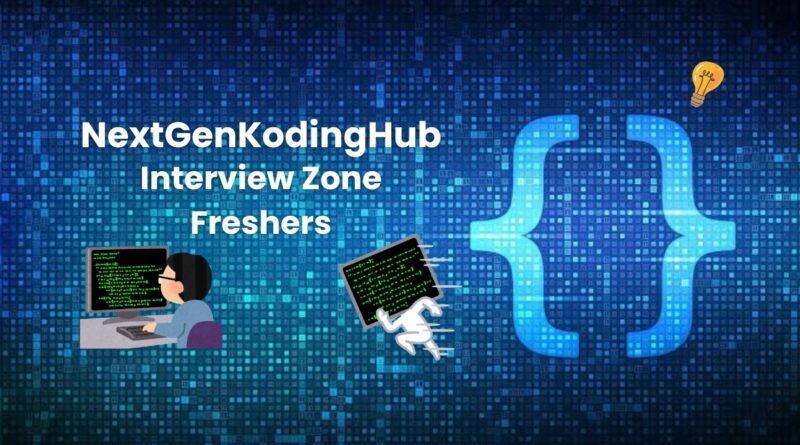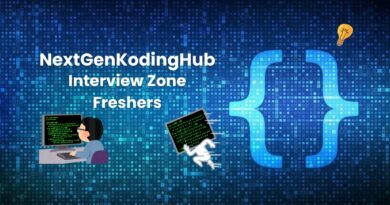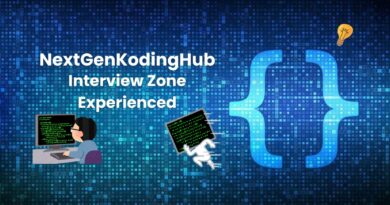Backend Developer Interview (Fresher)
Interview Zone: Backend Developer Interview Preparation
Top 30+ Backend Developer Interview Questions for Freshers
If you’re a fresher looking to step into backend development, it’s essential to familiarize yourself with the most common backend developer interview questions for freshers. This detailed guide presents 30+ of the latest and most frequently asked questions, organized into easy, intermediate, and advanced categories. These questions span important areas like programming basics, database management, API integration, server operations, and backend security. As you move through the list, you’ll gain a stronger grasp of backend concepts—helping you feel more prepared and confident in your interviews.
Furthermore, backend development plays a vital role in building scalable and efficient web applications. Unlike frontend development, which focuses on user interfaces, backend development handles business logic, database operations, and server-side processing. Hence, mastering these interview questions for backend developer freshers can significantly improve your chances of landing your dream job.
Easy Backend Developer Interview Questions for Freshers
1. What is backend development?
Backend development involves building and maintaining the server-side components of web applications. This includes writing the code that interacts with databases, processes user requests, and serves the correct data to the frontend. In short, backend developers ensure the application functions smoothly behind the scenes.
2. Which programming languages are commonly used in backend development?
Common backend programming languages include Python, Java, PHP, Ruby, C#, and JavaScript (Node.js). Each language has frameworks that simplify backend development, such as Django for Python or Spring for Java.
3. What is a server, and how does it work?
A server is a computer or software that listens for requests from clients (usually browsers) and sends back responses. When a user visits a website, their browser sends a request to the server, which processes it and returns the appropriate data or webpage.
4. Explain what an API is.
API stands for Application Programming Interface. It is a set of rules that allows different software applications to communicate with each other. For backend development, APIs enable the frontend to request and receive data or services from the server.
5. What is a database, and why is it important?
A database stores data in an organized way, enabling efficient retrieval and manipulation. Backend applications rely on databases to store user information, application data, and more. Without databases, data management would be impossible.
6. What does SQL stand for, and what is it used for?
SQL stands for Structured Query Language. It is used to manage and manipulate relational databases by performing operations such as querying, updating, and deleting data.
7. What is REST and RESTful API?
REST (Representational State Transfer) is an architectural style for designing networked applications. A RESTful API follows REST principles, allowing clients to communicate with servers using HTTP methods like GET, POST, PUT, and DELETE.
8. Differentiate between GET and POST HTTP methods.
GET requests retrieve data from the server and should not change server state. POST requests send data to the server, often causing changes like creating or updating records.
9. What is middleware in backend development?
Middleware is software that sits between the client request and the backend server. It processes requests, handles authentication, logging, and error handling before forwarding the request to the core backend logic.
10. Name some popular backend frameworks and their languages.
Popular backend frameworks include Django (Python), Express.js (Node.js), Spring Boot (Java), Laravel (PHP), and Ruby on Rails (Ruby). These frameworks offer ready-to-use tools that accelerate development.
Medium Backend Developer Interview Questions for Freshers
11. What does CRUD stand for in backend development?
CRUD stands for Create, Read, Update, and Delete—the four fundamental operations performed on database data.
12. What are RESTful APIs, and why are they used?
RESTful APIs use HTTP protocols to enable stateless communication between clients and servers. They are easy to implement, scalable, and widely adopted in modern web services.
13. Explain JSON and its role in backend development.
JSON (JavaScript Object Notation) is a lightweight format for exchanging data between clients and servers. It is easy to read and parse, making it ideal for APIs.
14. What is the difference between authentication and authorization?
Authentication verifies the identity of a user (e.g., login process), whereas authorization determines what actions or resources the authenticated user can access.
15. What is session management in backend development?
Session management tracks user state and activity across multiple HTTP requests. Sessions typically use cookies or tokens to maintain this state.
16. What are indexes in databases, and why are they important?
Indexes are data structures that improve the speed of data retrieval operations on a database table. They reduce query execution time but add overhead to write operations.
17. Differentiate between relational and non-relational databases.
Relational databases store structured data in tables with defined relationships using SQL. Non-relational (NoSQL) databases store unstructured or semi-structured data and include document, key-value, graph, and column-based stores.
18. Why are environment variables used in backend applications?
Environment variables store configuration settings (like database credentials, API keys) outside the codebase to enhance security and flexibility across environments.
19. Explain synchronous vs asynchronous programming in backend development.
Synchronous programming executes tasks sequentially, waiting for each to finish before starting the next. Asynchronous programming allows multiple tasks to run concurrently, improving performance especially for I/O operations.
20. What is dependency injection and its benefits?
Dependency injection is a design pattern where an object receives its dependencies from an external source rather than creating them internally. This promotes loose coupling and easier testing.
Advanced Interview Questions for Freshers
21. What is microservices architecture?
Microservices architecture breaks an application into small, independent services that communicate over APIs. This approach improves scalability, fault isolation, and team autonomy.
22. How does caching improve backend performance?
Caching temporarily stores frequently requested data in fast-access storage to reduce database queries and decrease response times.
23. What is load balancing?
Load balancing distributes incoming network traffic across multiple servers to improve application availability and reliability.
24. What are webhooks?
Webhooks are user-defined HTTP callbacks triggered by events. They allow backend systems to notify other services in real-time.
25. Explain different types of SQL joins.
SQL joins combine rows from two or more tables based on related columns. INNER JOIN returns matched rows, LEFT JOIN returns all from the left plus matched right, RIGHT JOIN returns all from the right plus matched left, and FULL JOIN returns all rows from both sides.
26. What is ORM (Object-Relational Mapping)?
ORM allows developers to interact with relational databases using objects in programming languages, abstracting SQL queries.
27. What is event-driven architecture?
In event-driven architecture, services communicate asynchronously by producing and consuming events, increasing scalability and decoupling.
28. What does the CAP theorem state?
The CAP theorem states that in distributed systems, you can only guarantee two of these three simultaneously: Consistency, Availability, and Partition tolerance.
29. What is a message queue, and why is it useful?
Message queues enable asynchronous communication by storing and forwarding messages between different services, helping with load leveling and decoupling.
30. How do you secure backend applications?
Security involves authentication, authorization, input validation, data encryption, using HTTPS, and protecting against common attacks like SQL injection and cross-site scripting.
31. What is containerization?
Containerization packages an application and its dependencies into a portable container to ensure consistent environments across development, testing, and production.
Conclusion
In conclusion, these backend developer interview questions for freshers cover fundamental to advanced topics. To excel, practice coding, build projects, and understand backend concepts thoroughly. This will prepare you well to face interviews confidently and impress potential employers.



